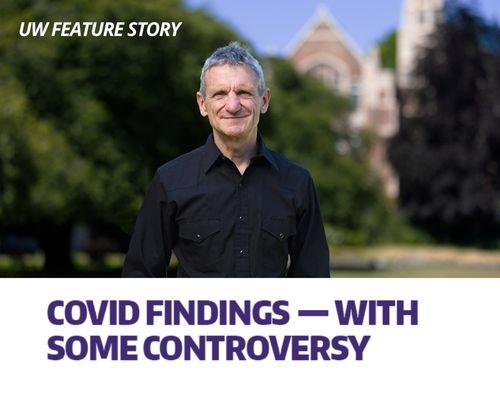According to the World Health Organization (WHO) in a report published in May 2022, nearly 15 million died globally from COVID-19 in the first two years of the pandemic, a number nearly three times larger than governments have previously reported (updated report in Nature December 2022).
Estimates are based on country-reported data and statistical modeling to account for excess deaths, the mortality above what would be expected based on the non-crisis mortality rate in the population of interest.
The production of these estimates is a result of a global collaboration supported by the work of the Technical Advisory Group for COVID-19 Mortality Assessment and country consultations.
One of the experts leading the statistical methodology used for this report is Jonathan Wakefield, University of Washington professor of statistics and biostatistics.
Counting unreported data
Arriving at these more accurate figures relied on a model derived using information from countries with adequate data, and generating estimates for countries with little or no data available.
For countries who have not supplied data, the Advisory Group formulated a model to use country characteristics such as temperature and containment measures, predicting the number they would have expected to see.
The model also takes into consideration indirect deaths due to COVID due to factors such as health care avoidance, as well as fewer deaths that may have occurred due to people traveling less, staying home, and wearing masks.
Wakefield has been interviewed and quoted by many media outlets since the report was first published to discuss the now publicly available methodology that WHO used to arrive at these worldwide estimates.
Resistance to WHO releasing death estimates
Some countries attempted to block the release of the report for several months, citing that the methodology used misrepresented their country’s data.
These arguments were not based on the scientific methodology used by the group, but rather distraction tactics to delay the data being released.
For some countries, like India, figures in the report were significantly higher.
WHO indicated 4.7 million excess deaths in India which was 9.8 times the country’s official Covid-19 death toll.
Jonathan Wakefield was interviewed on The Wire, India discussing Modi Government’s criticism of India’s COVID death toll.
The importance of counting every death
The methodology has been invaluable as many countries still lack capacity for reliable mortality surveillance and therefore do not collect and generate the data needed to calculate excess mortality.
Using the methodology, countries may use their own data to generate or update their own estimates.
Wakefield said, “I think every death should be recorded. For the people who died, out of respect to them and their families, I think it’s very important that we count those people. And from a public health perspective, it’s important to know how many deaths by month. When we can look at the deaths by month and look at the measures that were in place, this may help us in the future to avoid deaths, both as the COVID pandemic continues and for other pandemics.”
Errors in estimates
Scientists working with the World Health Organization (WHO) have corrected some surprising errors in its estimates of how many deaths the pandemic has caused, after a flurry of questions about the original WHO report.
In a revision to a technical paper on their methods, researchers cut Germany’s pandemic-related deaths estimate by 37%, pulling its excess death rate below those of the United Kingdom and Spain. They also raised their estimate for Sweden by 19%.
“Almost straight away, we realized there was a problem,” said Wakefield, whose team is in the process of re-examining all of its estimates.
More
You may learn more about the methodology used in the WHO report through the following links.
World Health Organization Downloads
-
WHO estimates of excess mortality associated with the COVID-19 pandemic final report (Nature)
- WHO news release
- Download the data files
- Methods for estimating the excess mortality associated with the COVID-19 pandemic
- Q&A on excess mortality as preferred method
TV & Radio
- WHO report finds nearly 15 million deaths associated with COVID-19 worldwide, PBS, Newshour, May 5, 2022
- CWHO Panel Head Counters ‘Unscientific’ Modi Government on India’s Covid Death Toll, The Wire, India, Checks & Balances, May 5, 2022
- Interview on BBC Newshour, BBC Newshour, May 5, 2022 (Interview with Wakefield begins at 36:46)
- True COVID-19 death toll could be three times higher than recorded, Radio New Zealand (RNZ), May 6, 2002
- Did the WHO get some of its excess death estimates wrong? BBC, More or Less, May 14, 2022
- Almost 15 million people died due to pandemic - WHO, RTÉ, Ireland's National Public Service Broadcaster
Newspaper/Web
- India is Stalling the W.H.O.’s Efforts to Make Global Covid Death Toll Public, New York Times, April 18, 2022
- Covid: World’s true pandemic death toll nearly 15 million, says WHO, BBC, May 5, 2022
- The WHO Has Nearly Tripled Its Estimate Of The Pandemic’s Death Toll, BuzzFeed News, May 5, 2022
- Nearly 15 million deaths related to covid-19, WHO estimates, The Washington Post, May 5, 2022
- WHO used different method for Covid deaths in India, The Economic Times, India, May 9, 2022
- Covid toll: Lead author of WHO study says Centre’s twin claims ‘misleading’, The Telegraph, India
- Excess mortality: WHO authors correct data for Germany and Sweden, aerzteblatt.de, Germany
- World Health Organisation estimates COVID-19 has killed nearly 15 million people globally, SBS News, Australia
Jonathan Wakefield
